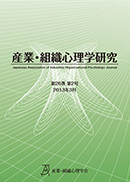Volume 26, Issue 2
Displaying 1-8 of 8 articles from this issue
- |<
- <
- 1
- >
- >|
-
2013Volume 26Issue 2 Pages 91-105
Published: 2013
Released on J-STAGE: August 05, 2019
Download PDF (1488K) -
2013Volume 26Issue 2 Pages 107-120
Published: 2013
Released on J-STAGE: August 05, 2019
Download PDF (1818K) -
2013Volume 26Issue 2 Pages 121-138
Published: 2013
Released on J-STAGE: August 05, 2019
Download PDF (1457K) -
2013Volume 26Issue 2 Pages 139-153
Published: 2013
Released on J-STAGE: August 05, 2019
Download PDF (1845K) -
2013Volume 26Issue 2 Pages 155-167
Published: 2013
Released on J-STAGE: August 05, 2019
Download PDF (1582K) -
2013Volume 26Issue 2 Pages 177-183
Published: 2013
Released on J-STAGE: October 08, 2020
Download PDF (1291K) -
2013Volume 26Issue 2 Pages 185-191
Published: 2013
Released on J-STAGE: October 08, 2020
Download PDF (1370K) -
2013Volume 26Issue 2 Pages 193-197
Published: 2013
Released on J-STAGE: October 08, 2020
Download PDF (1234K)
- |<
- <
- 1
- >
- >|
